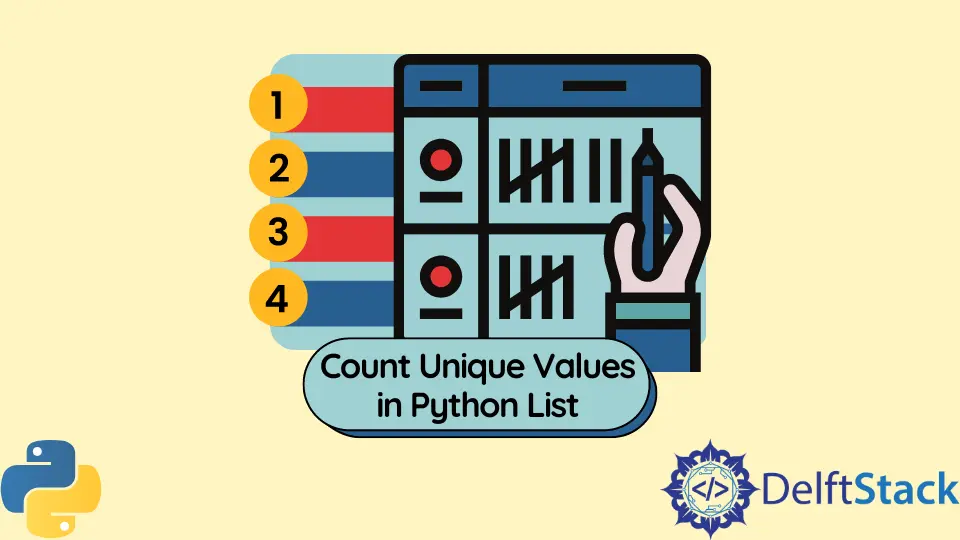How to Count Unique Values in Python List
-
Using the
set()Function - Using the collections.Counter Class
- Using NumPy for Larger Datasets
- Conclusion
- FAQ

Counting unique values in a Python list is a common task for data analysis and manipulation. Whether you’re working with datasets, logs, or any collection of items, knowing how many distinct elements are present can provide valuable insights. In Python, there are several straightforward methods to achieve this, each with its own advantages.
In this article, we’ll explore various techniques for counting unique values in a list, including using built-in functions, collections, and NumPy. By the end, you’ll have a solid understanding of how to efficiently count unique values in any Python list, enhancing your data processing skills.
Using the set() Function
One of the simplest and most efficient ways to count unique values in a Python list is by using the built-in set() function. The set() function creates a set object, which inherently contains only unique elements. By converting a list to a set, you can easily determine the number of unique values.
Here’s how you can do it:
my_list = [1, 2, 2, 3, 4, 4, 5]
unique_values = set(my_list)
count_unique = len(unique_values)
print(count_unique)
Output:
5
In this example, we start with a list containing some duplicate values. By passing my_list to the set() function, we create a set that automatically removes duplicate entries. The len() function then counts the number of unique elements in the set. This method is not only concise but also very efficient, particularly for larger lists, as the set data structure is optimized for uniqueness checks.
Using the collections.Counter Class
Another effective way to count unique values in a Python list is by utilizing the Counter class from the collections module. This method is particularly useful when you want not just to count unique values but also to see how many times each unique element appears in the list.
Here’s a practical example:
from collections import Counter
my_list = ['apple', 'banana', 'apple', 'orange', 'banana', 'kiwi']
counter = Counter(my_list)
unique_count = len(counter)
print(unique_count)
Output:
4
In this code, we first import the Counter class. We then create a Counter object by passing our list, which counts the occurrences of each item. The resulting counter object is a dictionary-like structure where the keys are the unique elements and the values are their respective counts. Finally, we use len(counter) to get the number of unique items. This method is particularly powerful if you’re interested in frequency distribution, as it provides additional insights beyond just the count of unique values.
Using NumPy for Larger Datasets
When dealing with large datasets, performance becomes critical. In such cases, using NumPy can be beneficial due to its optimized performance for numerical operations. NumPy provides a straightforward way to count unique values using the numpy.unique() function.
Here’s an example of how to use NumPy for this purpose:
import numpy as np
my_array = np.array([1, 2, 2, 3, 4, 4, 5])
unique_values = np.unique(my_array)
count_unique = unique_values.size
print(count_unique)
Output:
5
In this example, we first import the NumPy library and create a NumPy array from our list. The np.unique() function is then called, which returns the unique values in the array. The size of the resulting array gives us the count of unique elements. This method is particularly efficient for large datasets, as NumPy is designed for high-performance numerical operations and can handle large arrays more effectively than standard Python lists.
Conclusion
Counting unique values in a Python list is a fundamental skill that can significantly enhance your data analysis capabilities. Whether you choose to use the set() function for simplicity, the Counter class for detailed frequency analysis, or NumPy for performance with larger datasets, each method has its strengths. Understanding these techniques will empower you to handle data more effectively in your projects. As you continue to work with Python, mastering these skills will open the door to more advanced data manipulation and analysis tasks.
FAQ
- What is the fastest way to count unique values in a list?
Using the set() function is generally the fastest way to count unique values in a list due to its optimized performance.
-
Can I count unique values in a list of strings?
Yes, you can use any of the methods mentioned, such as set() or collections.Counter, to count unique string values in a list. -
Is there a method to count unique values in a nested list?
You would need to flatten the nested list first before applying any of the counting methods. You can use list comprehensions or libraries like itertools for flattening. -
How does the collections.Counter class work?
The collections.Counter class creates a dictionary-like object that counts the occurrences of each unique element in a list. -
Can I use pandas to count unique values in a list?
Yes, pandas provides a very efficient way to count unique values using theunique()method or thevalue_counts()function.
Founder of DelftStack.com. Jinku has worked in the robotics and automotive industries for over 8 years. He sharpened his coding skills when he needed to do the automatic testing, data collection from remote servers and report creation from the endurance test. He is from an electrical/electronics engineering background but has expanded his interest to embedded electronics, embedded programming and front-/back-end programming.
LinkedIn FacebookRelated Article - Python List
- How to Convert a Dictionary to a List in Python
- How to Remove All the Occurrences of an Element From a List in Python
- How to Remove Duplicates From List in Python
- How to Get the Average of a List in Python
- What Is the Difference Between List Methods Append and Extend
- How to Convert a List to String in Python
